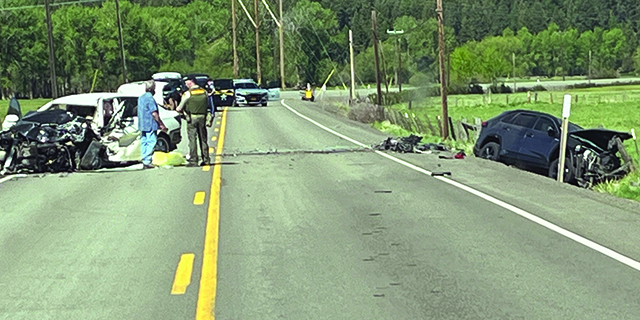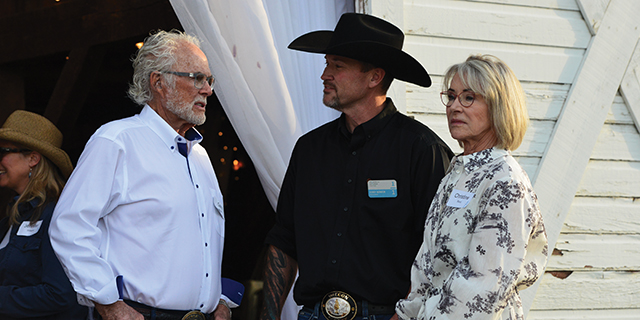Workshop speaker: Sunspots, not fossil fuels, agents of climate change
Published 10:01 am Monday, January 26, 2009
A photo of the sun showing an absence of sunspot activity during August captured the attention of about 350 ranchers in La Grande Saturday when Gary Sides, cattle nutritionist for Pfizer Animal Health, argued that changes in sunspot activity, not greenhouse gases, are primarily responsible for global climate change.
Based on recent sunspot activity, Sides told ranchers attending the fifth-annual Cattleman’s Workshop, global warming appears to be giving way to a period of global cooling that could signal the next mini ice age.
And contrary to Al Gore and others, Sides contends, the changes have nothing to do with greenhouse gases.
The theory that sunspot activity, rather than the burning of fossil fuels, drives global climate change could have major implications not only on individual ranches and farmers, but on the world’s food supply, Sides said.
Unless alternative fuels become readily available and affordable, he contends, fossil fuels will remain vital to the world’s ability to feed its ever-growing population, particularly in developing regions.
The standing-room-only crowd at the Blue Mountain Conference Center erupted into cheers when Sides said he believes that evidence supporting the sunspot theory of global warming and cooling is winning over scientists around the world.
“In August 2008 there were zero sunspots on the sun,” Sides said. “That’s the first time that’s happened in 300 years, and we had a mini ice age (then).”
“There was no human activity that caused the mini ice age,” Sides said.
He displayed graphs which show no correlation between peaks and valleys in greenhouse gases and global warming and cooling periods over the years. Other graphs show that sunspot activity rose and fell along with global temperature changes.
The last mini ice age forced farmers in the United Kingdom to switch from growing wine grapes to grains, which is one reason inhabitants of England, Scotland Wales and Ireland are beer drinkers, Sides said.
That’s just one example of agricultural changes that resulted from the last mini ice age, Sides said. He suggested that farmers and others consider the potential for colder weather when choosing what to plant this spring.
He pointed to temperatures 10 to 20 degrees below normal in many regions this winter, and to snow and sub-freezing weather that hit as late as June 11 last spring in Oregon and other western states as an indication that global cooling stemming from declines in sunspot activity has already begun.
If projections of a possible mini ice age come to pass, Sides said ranchers will have to figure out how to keep their calf crop from freezing and how to keep their cows healthy so their birth rates don’t fall as low as they are in the mountains of Peru, where the weather is so harsh cows have a calf every two or three years.
Laughter filled the conference center when Sides joked that he became a believer in stories about the U.S. military allegedly recovering a crashed spacecraft and alien bodies near Roswell, N.M., in 1947, when he learned that Gore was born nine months after the incident.
Sides went on to blast environmental groups for calling past government support of the fossil fuel industry a mistake.
“What would our society look like without the internal combustion engine?” Sides said.
He showed slides of people struggling to scratch out an existence in areas of Africa, the Middle East and South America where farmers still rely on horses rather than gas- or diesel-powered machines.
Sides reminded the audience that less than a century ago, such primitive farming and ranching practices were prevalent in the United States.
He asked the audience to think about how much the world changed in one generation. He talked about his grandfather, who grew up in the United States in the late 1800s and early 1900s, when farming was done with horse-drawn plows and wagons.
Sides said his father died in 1953, 15 months after he was born, because the polio vaccine was not yet widely available.
More than 5 million people in the United States and 50 million worldwide died from the Spanish flu between World War I and World War II, including 75 out of 80 people in an Alaskan village who died within five days after an infected postal carrier delivered the mail.
Without modern vaccines and antibiotics made from fossil fuel derivatives, Sides said a worldwide pandemic like the Spanish flu could have similar or worse effects in the future.
“We take technology for granted today,” Sides said, asking the audience to imagine what it would be like if the world runs out of fossil fuels before alternatives are available to run machines and make everything from clothes and computers to fertilizers and vaccines.
With the world’s population projected to add between 1 billion and 3 billion people in the next 40 years, Sides said farmers and ranchers will need ever-improving technology to triple food production on the available land.
On the upside, Sides said ranchers should benefit from higher beef prices created by soaring global demand as workers with rising wages in China, India and other countries compete for available beef with Americans, Europeans and other beef consumers.





